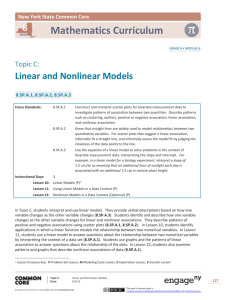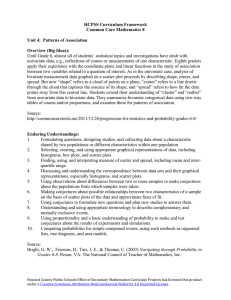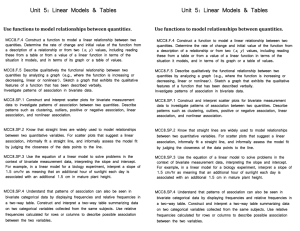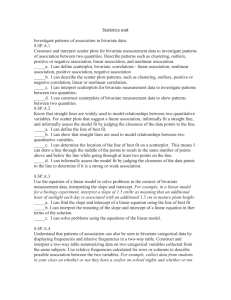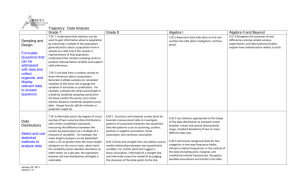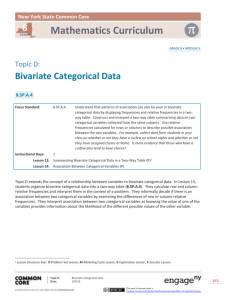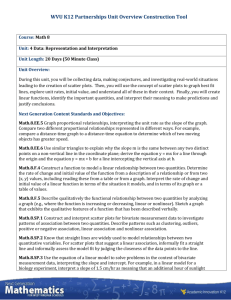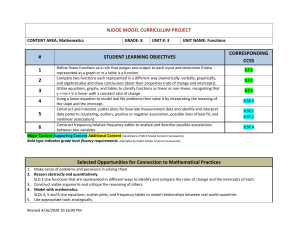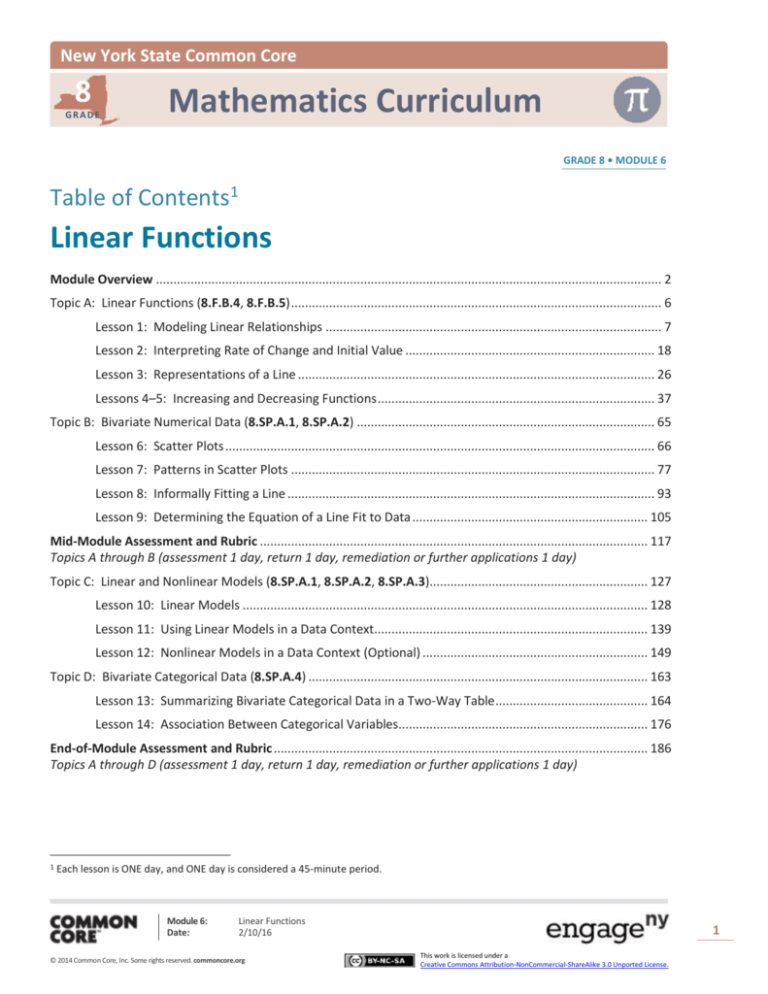
New York State Common Core
8
GRADE
Mathematics Curriculum
GRADE 8 • MODULE 6
Table of Contents1
Linear Functions
Module Overview .................................................................................................................................................. 2
Topic A: Linear Functions (8.F.B.4, 8.F.B.5) ........................................................................................................... 6
Lesson 1: Modeling Linear Relationships ................................................................................................. 7
Lesson 2: Interpreting Rate of Change and Initial Value ........................................................................ 18
Lesson 3: Representations of a Line ....................................................................................................... 26
Lessons 4–5: Increasing and Decreasing Functions ................................................................................ 37
Topic B: Bivariate Numerical Data (8.SP.A.1, 8.SP.A.2) ...................................................................................... 65
Lesson 6: Scatter Plots ............................................................................................................................ 66
Lesson 7: Patterns in Scatter Plots ......................................................................................................... 77
Lesson 8: Informally Fitting a Line .......................................................................................................... 93
Lesson 9: Determining the Equation of a Line Fit to Data .................................................................... 105
Mid-Module Assessment and Rubric ................................................................................................................ 117
Topics A through B (assessment 1 day, return 1 day, remediation or further applications 1 day)
Topic C: Linear and Nonlinear Models (8.SP.A.1, 8.SP.A.2, 8.SP.A.3)............................................................... 127
Lesson 10: Linear Models ..................................................................................................................... 128
Lesson 11: Using Linear Models in a Data Context............................................................................... 139
Lesson 12: Nonlinear Models in a Data Context (Optional) ................................................................. 149
Topic D: Bivariate Categorical Data (8.SP.A.4) .................................................................................................. 163
Lesson 13: Summarizing Bivariate Categorical Data in a Two-Way Table ............................................ 164
Lesson 14: Association Between Categorical Variables........................................................................ 176
End-of-Module Assessment and Rubric ............................................................................................................ 186
Topics A through D (assessment 1 day, return 1 day, remediation or further applications 1 day)
1
Each lesson is ONE day, and ONE day is considered a 45-minute period.
Module 6:
Date:
Linear Functions
2/10/16
© 2014 Common Core, Inc. Some rights reserved. commoncore.org
1
This work is licensed under a
Creative Commons Attribution-NonCommercial-ShareAlike 3.0 Unported License.
Module Overview
NYS COMMON CORE MATHEMATICS CURRICULUM
8•6
Grade 8 • Module 6
Linear Functions
OVERVIEW
In Grades 6 and 7, students worked with data involving a single variable. This module introduces students to
bivariate data. Students are introduced to a function as a rule that assigns exactly one value to each input. In
this module, students use their understanding of functions to model the relationships of bivariate data. This
module is important in setting a foundation for students’ work in Algebra I.
Topic A examines the relationship between two variables using linear functions (8.F.B.4). Linear functions are
connected to a context using the initial value and slope as a rate of change to interpret the context. Students
represent linear functions by using tables and graphs and by specifying rate of change and initial value. Slope
is also interpreted as an indication of whether the function is increasing or decreasing and as an indication of
the steepness of the graph of the linear function (8.F.B.5). Nonlinear functions are explored by examining
nonlinear graphs and verbal descriptions of nonlinear behavior.
In Topic B, students use linear functions to model the relationship between two quantitative variables as
students move to the domain of statistics and probability. Students make scatter plots based on data. They
also examine the patterns of their scatter plots or given scatter plots. Students assess the fit of a linear model
by judging the closeness of the data points to the line (8.SP.A.1, 8.SP.A.2).
In Topic C, students use linear and nonlinear models to answer questions in context (8.SP.A.1, 8.SP.A.2).
They interpret the rate of change and the initial value in context (8.SP.A.3). They use the equation of a linear
function and its graph to make predictions. Students also examine graphs of nonlinear functions and use
nonlinear functions to model relationships that are nonlinear. Students gain experience with the
mathematical practice of “modeling with mathematics” (MP.4).
In Topic D, students examine bivariate categorical data by using two-way tables to determine relative
frequencies. They use the relative frequencies calculated from tables to informally assess possible
associations between two categorical variables (8.SP.A.4).
Focus Standards
Use functions to model relationships between quantities.
8.F.B.4
Construct a function to model a linear relationship between two quantities. Determine the
rate of change and initial value of the function from a description of a relationship or from
two (𝑥,𝑦) values, including reading these from a table or from a graph. Interpret the rate of
change and initial value of a linear function in terms of the situation it models, and in terms of
its graph or a table of values.
Module 6:
Date:
Linear Functions
2/10/16
© 2014 Common Core, Inc. Some rights reserved. commoncore.org
2
This work is licensed under a
Creative Commons Attribution-NonCommercial-ShareAlike 3.0 Unported License.
NYS COMMON CORE MATHEMATICS CURRICULUM
8.F.B.5
Module Overview
8•6
Describe qualitatively the functional relationship between two quantities by analyzing a graph
(e.g., where the function is increasing or decreasing, linear or nonlinear). Sketch a graph that
exhibits the qualitative features of a function that has been described verbally.
Investigate patterns of association in bivariate data.2
8.SP.A.1
Construct and interpret scatter plots for bivariate measurement data to investigate patterns
of association between two quantities. Describe patterns such as clustering, outliers, positive
or negative association, linear association, and nonlinear association.
8.SP.A.2
Know that straight lines are widely used to model relationships between two quantitative
variables. For scatter plots that suggest a linear association, informally fit a straight line, and
informally assess the model fit by judging the closeness of the data points to the line.
8.SP.A.3
Use the equation of a linear model to solve problems in the context of bivariate measurement
data, interpreting the slope and intercept. For example, in a linear model for a biology
experiment, interpret a slope of 1.5 cm/hr as meaning that an additional hour of sunlight
each day is associated with an additional 1.5 cm in mature plant height.
8.SP.A.4
Understand that patterns of association can also be seen in bivariate categorical data by
displaying frequencies and relative frequencies in a two-way table. Construct and interpret a
two-way table summarizing data on two categorical variables collected from the same
subjects. Use relative frequencies calculated for rows or columns to describe possible
association between the two variables. For example, collect data from students in your class
on whether or not they have a curfew on school nights and whether or not they have assigned
chores at home. Is there evidence that those who have a curfew also tend to have chores?
Foundational Standards
Solve real-life and mathematical problems using numerical and algebraic expressions and
equations.
7.EE.B.4
Use variables to represent quantities in a real-world or mathematical problem, and construct
simple equations and inequalities to solve problems by reasoning about the quantities.
Define, evaluate, and compare functions.
2
3
8.F.B.1
Understand that a function is a rule that assigns to each input exactly one output. The graph
of a function is the set of ordered pairs consisting of an input and the corresponding output.3
8.F.B.2
Compare properties of two functions each represented in a different way (algebraically,
graphically, numerically in tables, or by verbal descriptions). For example, given a linear
function represented by a table of values and a linear function represented by an algebraic
expression, determine which function has the greater rate of change.
8.SP standards are used as applications to the work done with 8.F standards.
Function notation is not required in Grade 8.
Module 6:
Date:
Linear Functions
2/10/16
© 2014 Common Core, Inc. Some rights reserved. commoncore.org
3
This work is licensed under a
Creative Commons Attribution-NonCommercial-ShareAlike 3.0 Unported License.
Module Overview
NYS COMMON CORE MATHEMATICS CURRICULUM
8.F.B.3
8•6
Interpret the equation 𝑦 = 𝑚𝑥 + 𝑏 as defining a linear function, whose graph is a straight
line; give examples of functions that are not linear. For example, the function 𝐴 = 𝑠 2 giving
the area of a square as a function of its side length is not linear because its graph contains the
points (1,1), (2,4) and (3,9), which are not on a straight line.
Focus Standards for Mathematical Practice
MP.2
Reason abstractly and quantitatively. Students reason quantitatively by symbolically
representing the verbal description of a relationship between two bivariate variables. They
attend to the meaning of data based on the context of problems and the possible linear or
nonlinear functions that explain the relationships of the variables.
MP.4
Model with mathematics. Students model relationships between variables using linear and
nonlinear functions. They interpret models in the context of the data and reflect on whether
or not the models make sense based on slopes, initial values, or the fit to the data.
MP.6
Attend to precision. Students evaluate functions to model a relationship between numerical
variables. They evaluate the function by assessing the closeness of the data points to the line.
They use care in interpreting the slope and the 𝑦-intercept in linear functions.
MP.7
Look for and make use of structure. Students identify pattern or structure in scatter plots.
They fit lines to data displayed in a scatter plot and determine the equations of lines based on
points or the slope and initial value.
Terminology
New or Recently Introduced Terms
Association (An association is a relationship between two variables. The tendency for two variables
to vary together in a predictable way.)
Column relative frequency (In a two-way table, a column relative frequency is a cell frequency
divided by the column total for that cell.)
Row relative frequency (In a two-way table, a row relative frequency is a cell frequency divided by
the row total for that cell.)
Two-way table (A two-way table is a table used to summarize data on two categorical variables. The
rows of the table correspond to the possible categories for one of the variables, and the columns of
the table correspond to the possible categories for the other variable. Entries in the cells of the table
indicate the number of times that a particular category combination occurs in the data set or the
frequency for that combination.)
Module 6:
Date:
Linear Functions
2/10/16
© 2014 Common Core, Inc. Some rights reserved. commoncore.org
4
This work is licensed under a
Creative Commons Attribution-NonCommercial-ShareAlike 3.0 Unported License.
Module Overview
NYS COMMON CORE MATHEMATICS CURRICULUM
8•6
Familiar Terms and Symbols4
Categorical variable
Intercept or Initial value
Numerical variable
Scatter plot
Slope
Suggested Tools and Representations
Graphing calculator
Scatter plot
Two-way tables
Curfew
No Curfew
Total
Assigned
Chores
25
10
35
Not
Assigned
Chores
8
7
15
Total
33
17
50
130
Foal Weight (kg)
120
110
100
90
0
0
500
510
520
530
540
550
560
Mare Weight (kg)
570
580
590
Scatter Plot
Two-way Table
Assessment Summary
Assessment Type Administered
4
Format
Standards Addressed
Mid-Module
Assessment Task
After Topic B
Constructed response with rubric
8.F.B.4, 8.F.B.5,
8.SP.A.1, 8.SP.A.2
End-of-Module
Assessment Task
After Topic D
Constructed response with rubric
8.F.B.4, 8.F.B.5,
8.SP.A.1, 8.SP.A.2,
8.SP.A.3, 8.SP.A.4
These are terms and symbols students have seen previously.
Module 6:
Date:
Linear Functions
2/10/16
© 2014 Common Core, Inc. Some rights reserved. commoncore.org
5
This work is licensed under a
Creative Commons Attribution-NonCommercial-ShareAlike 3.0 Unported License.

